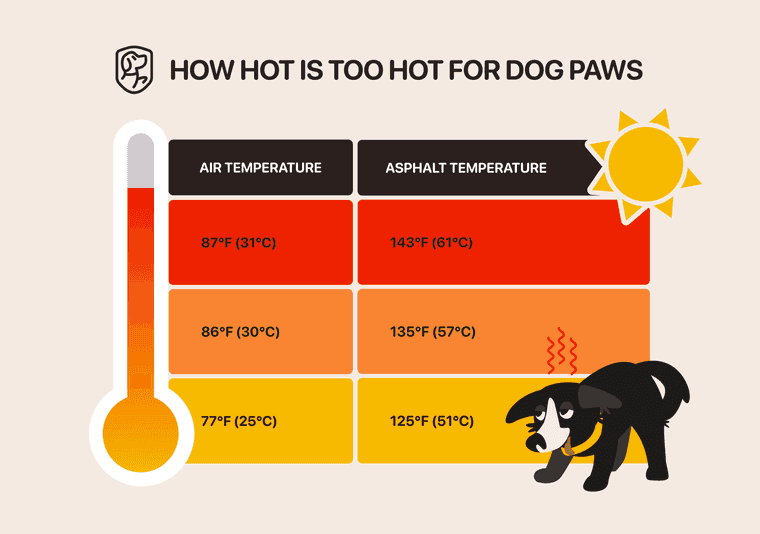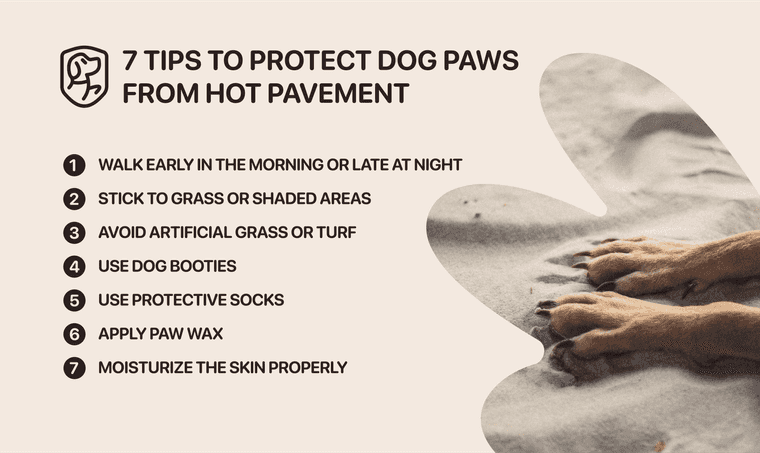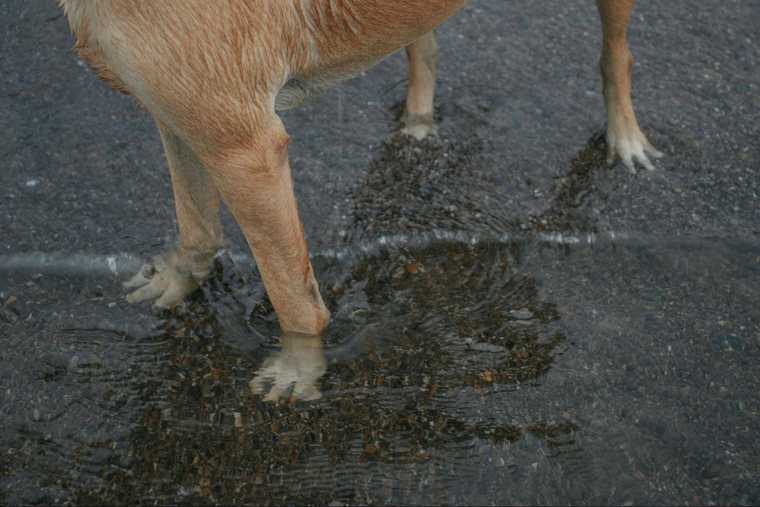How to Protect Dog Paws From Hot Pavement: 7 Expert Tips

By
Woofz Team Updated on |Reviewed by
Karen PiwinskiHot weather poses multiple risks for your furry companion. Some, such as overheating or dehydration, are more obvious to pet owners, as these are conditions that humans are also prone to when the temperature outside rises. Others are often overlooked, but they’re equally dangerous.
One of these hidden hazards is hot concrete or asphalt, which can cause damage to your dog’s paws. Continue reading to discover how dog owners can protect their dogs’ feet on a hot sidewalk and make summer walks safer.
When Is It Too Hot to Walk Your Dog on Pavement
Asphalt and concrete heat up quickly under direct sunlight. Even if the weather is still relatively safe for a dog to be outside, the pavement can become dangerous for your companion to step on, as it can cause burns to the sensitive skin on their paw pads. According to Dr. Jerry Klein, DVM, Chief Veterinary Officer for the AKC, young dogs and puppies are especially susceptible to this type of injury.

To determine whether it’s safe to walk a dog in a particular area, use the methods described below. One way to check the pavement temperature is by checking it with the back of your hand. Place your hand on the surface and check if you can keep it there for around seven seconds. If you can do it, your dog doesn’t risk burning their paws stepping on this surface.
You can also rely on the approximate difference in temperature between air and asphalt (or other similar materials). Due to a high level of sunlight absorption, sidewalks can become 20–40°F (11-22°C) warmer than the surrounding air temperature. When the temperature of the sidewalk reaches 120°F (49°C), burns can occur in as fast as 60 seconds.

7 Tips on How to Protect Dogs' Feet From Hot Pavement
If taking a walk in the summer heat is unavoidable, ensure your pet’s paws are appropriately protected. You can do this by adjusting the time and route of your walks or by using special devices and products to add an extra layer of protection for the sensitive skin on your dog’s paws. Here are some safety considerations.
1. Walk early in the morning or late at night

Adjusting the timing of the walks can be crucial in protecting your furry companion from the heat. Avoid going outside in peak hours during the afternoon. Instead, opt for cooler periods of the day, such as early morning or late in the evening after sunset. Also, always test the sidewalk (use the 7-second rule) before letting your dog step on it.
2. Stick to grass or shaded areas
If you must go out with your pet during the day, avoid asphalt or concrete.

You can change the route you walk and visit places with plenty of shade and grass coverage, which don’t get so hot. Visiting the dog park, where your dog can walk off-leash in a safe environment, is a great alternative.
3. Avoid artificial grass or turf
Artificial grass and turf retain heat and can become dangerously hot, especially if they’re placed under direct summer sun. Although high-quality artificial grass can be less hazardous, it’s best to assume it's hot and discourage your dog from walking on it. If walking on it is absolutely necessary, test it with your palm and choose the areas with enough shade.
4. Use dog booties

It may happen, though, that you don’t have a choice but to walk your dog on a street with asphalt coverage. In these cases, using physical protection for the dog’s feet is essential. Dog booties are an excellent choice, as they offer a barrier that isolates the dog’s skin from hot surfaces.
Note that some dogs struggle to adjust to wearing shoes as they feel uncomfortable in them. Dedicate some time to practicing wearing the booties at home before taking your pet for a walk wearing them.
5. Use protective socks
You may prefer using socks to protect your dog’s paws. They’re more prone to wearing down, which can be a disadvantage. However, it can be a good alternative for dogs that struggle to get used to wearing booties or those with paw deformities.
6. Apply paw wax

Another popular option is using paw wax. It’s designed to protect your dog’s paws not only against hot surfaces but also against harmful chemicals they can step on. Simply cover your dog’s paw pads with wax before going outside. However, keep in mind that some dogs may try to lick it off right away – if that’s the case, paw wax might not be the best solution for them.

7. Moisturize the skin properly
To prevent dryness and cracking of the skin due to high temperatures, consider regularly moisturizing a dog’s feet. You can use special paw balms designed for canines (avoid applying products for humans). They will keep the paw skin healthy and add a protective barrier against hot surfaces.
How to Tell If Your Dog Has Burnt Paws
Unfortunately, you may fail to prevent damage to your dog’s feet. Sometimes, as little as a 1-minute walk is enough to cause burns to the sensitive skin on the paws. To help your pooch promptly and seek veterinary advice if necessary, you must know how to tell if your dog’s paw pads are burned. Make it a habit to gently pick up your dog’s feet and inspect their paws – visual checks can help you catch early signs of injury.
Signs of burnt dog paws include:
- Limping or reluctance to walk due to pain
- Excessive licking or chewing of the paws
- Atypical or excessive vocalization, such as barking, whining, or whimpering
- Frequent and heavy panting

- Redness and inflammation of the skin of a dog’s paw pads
- Blisters
- Darkening or discoloration of the skin
- Peeling or cracked paw pads.
How to Treat Burned Dog Paws and Ease Their Discomfort
Burnt paw pads can cause significant pain and discomfort to your furry friend. It’s vital to act early to help them alleviate the discomfort and prevent more serious damage to the skin. The advice below is for at-home solutions, which can be used when the damage to the feet isn’t severe. For more serious burns, consulting a vet is obligatory.

-
Immediate cooling: Reduce the heat and the inflammation of the skin by flushing the paws with cool water. You can also apply a cool compress made from a clean, wet cloth. Avoid rubbing the skin or using ice packs for cooling purposes.
-
Cleaning and assessment: Gently and carefully remove any dirt or debris from the skin and estimate the severity of the damage. Check the skin color and look for any bruises or signs of oozing.
-
Soothing and protection: Help calm down the irritation by applying paw balm or aloe. Cover the paws with a light bandage. It shouldn’t be too tight, but it should be fixed well enough to prevent a dog from licking the skin.
-
Seeking veterinary care: If you suspect the burn is deep and affects the inner layers of the skin, contact your vet immediately for further assistance. The same is true if the pain persists or if you notice signs of a bacterial infection.
-
Prevention: Act proactively and avoid situations where skin burns can occur. Don’t walk during the afternoon, choose parks instead of concrete or asphalt sidewalks, and use paw protection to prevent skin burns.

Wrap Up
The summer heat poses numerous risks to our furry friends, including skin burns from walking on hot surfaces. Remember, asphalt and concrete get dangerously hot for canines even when the air temperature is relatively mild. That’s why it’s vital to stick to safety rules to prevent burns on a dog’s paw pads. If a burn does happen, act quickly to minimize the damage and seek veterinary advice.

